March 2008
Monthly Archive
Wed 19 Mar 2008
Posted by boz under
BooksComments Off on Book: Passionate Minds by David Bodanis
[I’m posting this now, but read the book 9/2007].
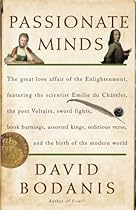 Passionate Minds (2006) is a dual biography of Voltaire (1694-1778) and Emilie du Chatelet (1706-1749). They met in 1733, when Emilie was 27 (and Voltaire was 39). This was an enjoyable and informative book, especially since I had never heard of Emilie du Chatelet (and only a passing knowledge of Voltaire). While the book does read something like a romance novel, there is enough substance to keep your attention.
Passionate Minds (2006) is a dual biography of Voltaire (1694-1778) and Emilie du Chatelet (1706-1749). They met in 1733, when Emilie was 27 (and Voltaire was 39). This was an enjoyable and informative book, especially since I had never heard of Emilie du Chatelet (and only a passing knowledge of Voltaire). While the book does read something like a romance novel, there is enough substance to keep your attention.
Emilie was married at the time she met Voltaire, but that didn’t stop them from having a very passionate affair. This, it turns out, was a fairly common thing to happen, and people looked the other way as long as they were discrete. Emilie’s husband also had a mistress, so things evened out. :)

Emilie was a brilliant woman, and she was translating (and understanding) Newton’s Principia. Voltaire was just a poet. Anyway, they had a very real “meeting of the minds” and Emilie could more than hold her own with Voltaire’s intellect.
The story of their 15-year relationship is great reading. It was fascinating to get a glimpse of the intrigue, etc. of France at the time (the French Revolution was after this, in 1789). One great story is how Voltaire and Emilie turned a rural chateau at Cirey into their own laboratory. They used it as a place to conduct experiments and write, and they were inseparable. They had created a space where they could think for themselves, with one supporting the other. They collaborated on a book, “The Principles of Newton”, which was a study of Newton’s “Principia Mathematica”.

Emilie was fluent in Latin and understood the mathematics (she explained the math to Voltaire, but he didn’t really get all of it). They actually setup and performed the experiments that Newton had described. “Principles of Newton” was published with only Voltaire’s name, but everyone knew of Emilie’s contribution (she was in correspondence with most of the great mathematicians of the day).
Emilie, on her own, completed a translation of the Principia – with commentary. It was the commentary that was fundamental to further developments of 18th century physics. She finished the manuscript while pregnant (with the child of a much younger man who subsequently dumped her). Emilie died a week or so after giving birth, at the age of 43. Voltaire lived with her at the end, and he lived on to be 84.
Wed 19 Mar 2008
Posted by boz under
BooksComments Off on Book: Seeker by Jack McDevitt
[I’m posting this now, but read the book 9/2007].
 Seeker (2005) is the third book in a series with the character Alex Benedict (following A Talent for War and Polaris). The main characters are the antiquities dealer Alex and his (female) assistant, Chase Kolpath. The Alex character reminds me of the Jonathan Gash character Lovejoy, and this book can be thought of as “Lovejoy in space”. This is a page-turner of an adventure story, with Alex and Chase trying to find the “lost colony” of Margolus. The story is set about 13,000 years in the future. Alex and Chase are shown a cup which they determine is 9,000 years old, and they believe it is from the interstellar ship, Seeker. Seeker was one of two ships that carried the original colonists 9,000 years before.
Seeker (2005) is the third book in a series with the character Alex Benedict (following A Talent for War and Polaris). The main characters are the antiquities dealer Alex and his (female) assistant, Chase Kolpath. The Alex character reminds me of the Jonathan Gash character Lovejoy, and this book can be thought of as “Lovejoy in space”. This is a page-turner of an adventure story, with Alex and Chase trying to find the “lost colony” of Margolus. The story is set about 13,000 years in the future. Alex and Chase are shown a cup which they determine is 9,000 years old, and they believe it is from the interstellar ship, Seeker. Seeker was one of two ships that carried the original colonists 9,000 years before.
Alex and Chase go on a hunt for the colony, and unknown people try to stop them…
Novel is told in the first person, from Chase’s point of view. Chase is actually the primary character. This is a fun read; I have Polaris on my queue.
Mon 17 Mar 2008
Posted by boz under
Art ,
Entertainment ,
Food and Wine ,
MusicComments Off on Chocolate Steak and David Russell

Kirsten and I had a great evening this past Saturday. We had dinner at Butterfield 9 in Washington D.C., before walking a block to see David Russell perform classical guitar at the Church of the Epiphany.
The dinner was great. The restaurant has a nice ambiance – quite elegant. Kirsten started her meal with the Longneck Squash Soup (goat cheese, roasted pancetta, and apple compote) – “Delicious”. She then had a 1/2 plate of the Carnaroli Risotto (glazed butternut squash, swiss chard, and black truffle) – “Delicious.
I had the “Chocolate Steak” (New England Elk, creamed parsnips, bitter chocolate, fleur de sel). The waiter said that elk tastes a bit like venison. That would be a good comparison, except that I have never had venison (that I remember). I figured I’d give it a try. Cooked medium-rare, the elk was melt-in-your-mouth delicious. It was coated with cocoa, making for a slightly crispy crust, while the bitter chocolate sauce under the steak was a neat complement; it definitely enhanced the flavors. My only issue was the size of the portions (small). Also, I was glad I ordered “Truffle potato puree” on the side, because what came with the steak was basically a garnish, and not a real side dish(es). The puree was delicious as well, though I would have preferred a more firm “mashed” potato side.
Neither Kirsten or I cared much for the “creme brulee” desert, as it was not a “classic” version; we would not have recognized it as creme brulee if not stated on the menu. It had a sort of “cookie” crust rather than caramelized sugar. The raspberry sorbet on the side with it was good.
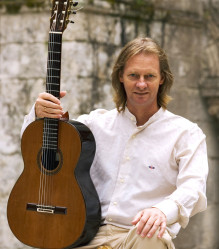
Butterfield 9 is only a block from the church where the concert was held, so we used valet parking at the restaurant and picked up the car after the concert.

The concert was very enjoyable; just Mr. Russell on a slightly raised platform at the front of the church with no amplification. I could hear the guitar just fine, but I had difficulty hearing his intros clearly (also partly due to his Scottish brogue :) ). The pews were hard to sit on for 2 hours (we were glad for intermission). The music however was great. We had been listening to his Bach and Baroque cd’s – but he didn’t play any of those pieces. I greatly enjoyed most of his pieces with the exception being the one that was actually written for him by a contemporary. Oh well.
Wed 12 Mar 2008
Posted by boz under
Archaeology ,
ArtComments Off on World’s Oldest Animation
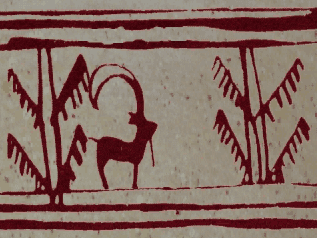 A 5200 year-old goblet (see image below) from the Burnt City in Iran has a series of images depicting a wild goat jumping up to get leaves from a tree. The animation shown is from an 11-minute documentary about the goblet (which was actually found ~1970). Basically, if you take each image in succession (like a flip-book), you get the animation. Neat.
A 5200 year-old goblet (see image below) from the Burnt City in Iran has a series of images depicting a wild goat jumping up to get leaves from a tree. The animation shown is from an 11-minute documentary about the goblet (which was actually found ~1970). Basically, if you take each image in succession (like a flip-book), you get the animation. Neat.
Note that the post-revolutionary Iranian archaeologists kinda got things wrong; they attribute the tree on the goblet to the “Assyrian Tree of Life”. But the goblet is from 1000 years before any mention of the Assyrian civilization in historical records. Ooops.
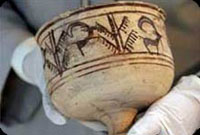
Sun 2 Mar 2008
Posted by boz under
ReligionComments Off on Loyola Retreat House
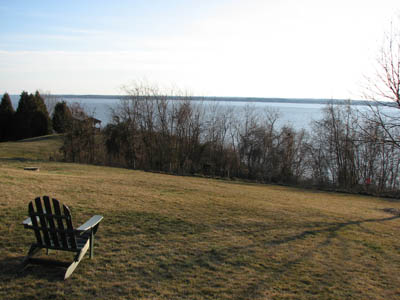
I just returned from a wonderful weekend Retreat at the Loyola Retreat House in Faulkner, MD. The House is right on the Potomac River, with beautiful, serene grounds overlooking the water. Surrounded by woods, there are also trails you can walk to enjoy nature even more. Inside the house are accommodations for about 68 or so retreatants. This past weekend (Feb 29-Mar 2, 2008) was a men’s retreat. Meant to be a time of contemplative prayer, it is a silent retreat to allow you to more easily get into the “spirit”. Three meals a day, Mass daily, and many lectures on prayer. Large blocks of time were devoted to individual prayer. You can attend as many or as few of the events as you like. The Jesuit priests (as well as Sisters and lay people) running the retreat were wonderful and quite approachable.
I last went on a retreat almost 30 years ago; other than “I liked it”, I don’t recall it at all. I believe I will be able to remember this retreat. With three kids, the youngest only 17mo, it’s not often I get to spend a weekend in “silence”, lost in my thoughts. Wonderful experience. This photo above is linked to some more pictures.
 Passionate Minds (2006) is a dual biography of Voltaire (1694-1778) and Emilie du Chatelet (1706-1749). They met in 1733, when Emilie was 27 (and Voltaire was 39). This was an enjoyable and informative book, especially since I had never heard of Emilie du Chatelet (and only a passing knowledge of Voltaire). While the book does read something like a romance novel, there is enough substance to keep your attention.
Passionate Minds (2006) is a dual biography of Voltaire (1694-1778) and Emilie du Chatelet (1706-1749). They met in 1733, when Emilie was 27 (and Voltaire was 39). This was an enjoyable and informative book, especially since I had never heard of Emilie du Chatelet (and only a passing knowledge of Voltaire). While the book does read something like a romance novel, there is enough substance to keep your attention.


 Seeker
Seeker




